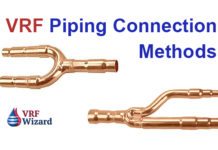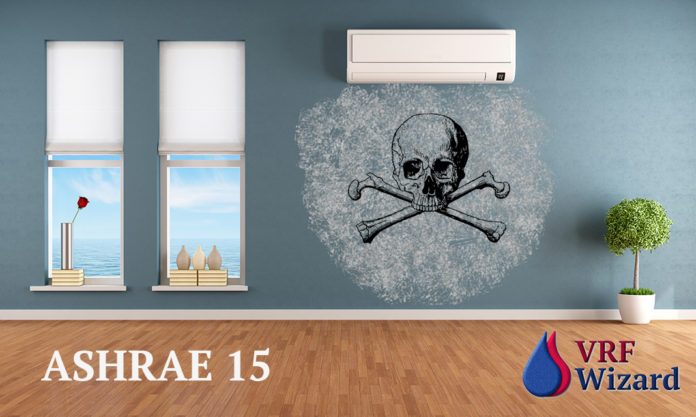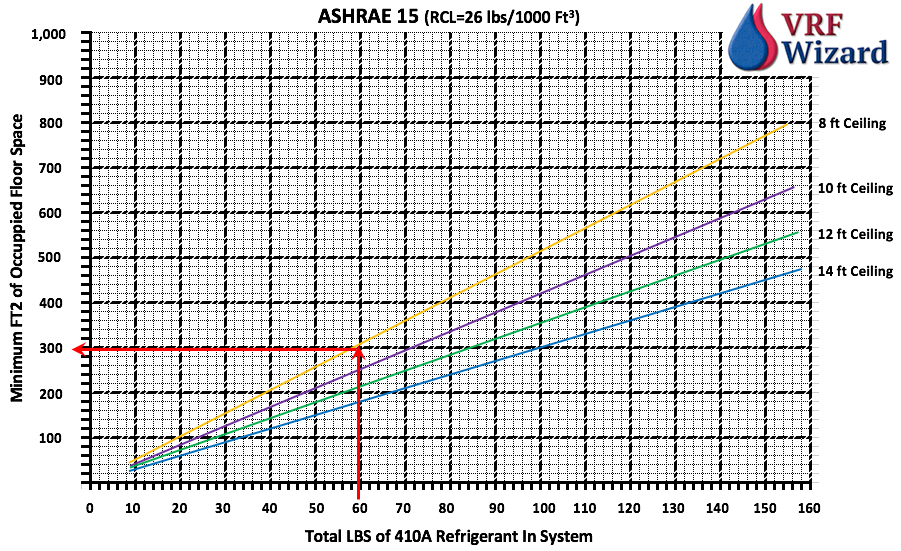VRF Systems and ASHRAE 15 & 34
When designing or considering the installation of a VRF (Variable Refrigerant Flow) system for a new building or a retrofit to an existing system, the ramifications of ASHRAE 15 can play a big part. ASHRAE 15 limits the amount of refrigerant that can be considered safe in an enclosed environment. ASHRAE 15 also applies to chiller rooms, where you will find the requirement for a refrigerant monitoring systems, which will sound an audible and visual alarm if a leak occurs. VRF systems require the calculation of the amount of refrigerant that if leaked from the system would infiltrate the enclosed space it is feeding. There are limits to how much refrigerant is allowed in a confined space. This requires that each system that is fed with refrigerant have a safe level for the occupants if a leak was to occur; institutional classifications have stricter requirements.
This becomes a problem when you have a small room being served by a VRF system, as there is not enough volume in the room to maintain safe levels if a leak was to occur. The thinking is that the if VRF system feeding that small space was to leak it would leak its total volume of refrigerant from the system into that room, raising the concentration of refrigerant to hazardous levels for the occupants. There are special gas monitors that can alert the occupants when a leak occurs.
VRF system manufactures have software programs that can perform the ASHRAE 15 calculations to identify any problem rooms. The software calculates the volume of refrigerant in the system, and can provide piping and wiring diagrams. There are several solutions to the problem of a small room not meeting the volume requirements of the ASHRAE 15 calculations from leaks of refrigerants.
- One is to obviously increase the volume that the leak can inhabit for that space. This could be adding transfer ducts to another space, which then includes the volume of both spaces in the calculation. If the attic or plenum space above the ceiling is used as a supply or return plenum then that area can be used in the volume calculations.
- Another solution would be to reduce the VRF system size feeding the small volume room. By reducing the size of the system, you are reducing the volume of refrigerant in the system.
- Also, reducing the length of piping reduces the amount of refrigerant required.
- For the unsolvable small room, you can resort to a dedicated mini-split system.
VRF Refrigerant Volume Calculations
You should check your local governing authority to see if they have adopted ASHRAE 15 & 34* as is, or if they have increased the requirements. ASHRAE 34 is a standard that allows up to 26 Lbs. for every 1,000 Ft3 of space volume if a leak was to occur for R410A refrigerant. This amount could be reduced in certain areas, as in our local area the city has adopted 25 Lbs. per 1,000 Ft3.
ASHRAE 34 also restricts that amount by half if the occupancy is classified as institutional. This means that if you had a Skilled Nursing facility which is classified as an institutional occupancy, the amount of refrigerant allowed would be 13 Lbs. per 1,000 Ft3 of space volume. The thinking is that in institutional facilities the occupants are non-ambulatory, meaning they need assistance to evacuate.
VRF ASHRAE 15 Chart


Sample Calculation. Using R401A with a RCL of 26 Lbs/1,000 Ft3 and 60 Lbs of refrigerant in the system we get the following minimum Ft2 of occupied floor area for an 8 foot ceiling; 288 Ft2
This means that the smallest occupied space that could be served from this system would be 288 Ft2.
Download a copy of the ASHRAE Chart here. ASHRAE 15 Chart PDF
If your system holds less than 6.6 Lbs. than you get immunity from the standard, but check with your (AHJ) Authority Having Jurisdiction to determine if they calculate the volume of the rooms the same as referenced here, as each jurisdiction has the power to redefine the standard the way they see fit. Power is awesome, when it’s you that has it.
R410 used in a lot of these systems is considered non-toxic and non-flammable.
The problem with the refrigerant in the way of safety is that it displaces the oxygen, you know that stuff humans need to survive. Hence the strict requirement on the allowable volume in a room if the system was to spring a leak, and the stricter requirement if the building is classified as an institutional facility.
Design Steps for a VRF System.
1) Determine the volume of each room.
2) Determine the zoning and piping layout.
3) Determine the amount of refrigerant in the system.
4) Determine the classification of the building or space to be served by the VRF.
5) Determine if any of the spaces are too small. (Exceeds the allowable amount of refrigerant)
6) Adjust zoning, space size or configuration to meet requirements.
7) Decide on a VRF Ventilation method to accomplish ASHRAE 62.1 requirements.
8) Determine if you will use a VRF Multi Port or Single Port Branch Selector Box layout.
* ASHRAE 34 classifies refrigerants for their hazard levels.
What issues have you experienced complying with ASHRAE 15 and Variable Refrigerant Flow systems?
Please leave us a comment below on your thoughts or experience with VRF ASHRAE 15.
Concerned about leaks, get this great refrigerant leak detector.































